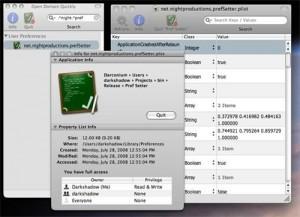
- Pref setter mac how to#
- Pref setter mac mac os x#
- Pref setter mac password#
- Pref setter mac series#
- Pref setter mac windows#
With Root still selected as the highlighted property, click the New Child button.
Pref setter mac mac os x#
Next, find a property called CreateDesktop (or create the Boolean property if it does not exist) and change/set its value from Yes to No.Ĭhange the "Finder." With this trick, you get Mac OS X to believe that the application it considers to be the Finder is something other than the Finder itself. If you prefer the "hands-on" approach, launch Property List Editor and return to the file. To do so, select Finder from its toolbar, enable the checkmark for "Disable Desktop features" and click to Relaunch Finder. To make this change, you can once again call on TinkerTool. This doesn't have much everyday value, but it can be useful in a public setting where you want to make the icons more difficult to access.

Pref setter mac windows#
Assuming no windows are open, all you will see is your Desktop background picture and the Dock. This unusual option makes all the icons on your desktop disappear. Change the property's value back to No to undo the change.Įliminate the Desktop. Now all the invisible files on your drive will magically appear.

So, here's the deal for invisibility status: All of the relevant utilities work by doing the same thing?modifying a property in a.
Pref setter mac series#
Of course, the point of this series has been how all of this works at the. To use it for this function, click the Finder icon in its toolbar, enable the "Show hidden and system files" checkmark, and click the "Relaunch Finder" button. Making invisible files visible is just one of several dozen things it can do. You don't even have to relaunch the application to go in reverse, as you do with most competing one-trick ponies.Īlternatively, if your prefer the economy of one utility for a variety of tasks, you still have a healthy selection from which to choose. Click the toggled button again to reverse the effect. Just launch it, click the "Show the Invisible files" button and you're done. My personal favorite is Show Hide Invisible Files. Instead, you can choose from among an array of utilities that do the "dirty work" for you. If you wish, you can accomplish the effect without having to "manually" edit the relevant. Among other uses, it is ideal for easy access to Mac OS X's Unix directories. This change let's you see all the files and folders on your drive that are otherwise invisible. I am surprised I did not mention this one already, but it appears I did not. plist "tricks." And they are all easy to do! However, if any of the steps below seem insufficiently explained, check with earlier installments of this series for needed details.

For this last installment, I offer a list of five more of my favorite.
Pref setter mac password#
These include getting widgets out of Dashboard, disabling Guest access for file sharing, turning off the requirement to provide a password in the Finder for certain actions, adding a Quit item to the Finder, and changing the magnification size of Dock icons. Over the course of this series, I have described some of the more useful or just-plain-fun things you can accomplish by making modifications to various. For all the details, see Parts I & II, Part III, Part IV, Part V and Part VI. plist files located outside your home directory. plist file problems, and what you should know about.
Pref setter mac how to#
plist files, how to edit these files (including working with "hidden" settings), how to troubleshoot. plist files are, how to interpret the content of.

Welcome to the final installment of the tutorial series that covers everything you ever wanted to know about.


 0 kommentar(er)
0 kommentar(er)
